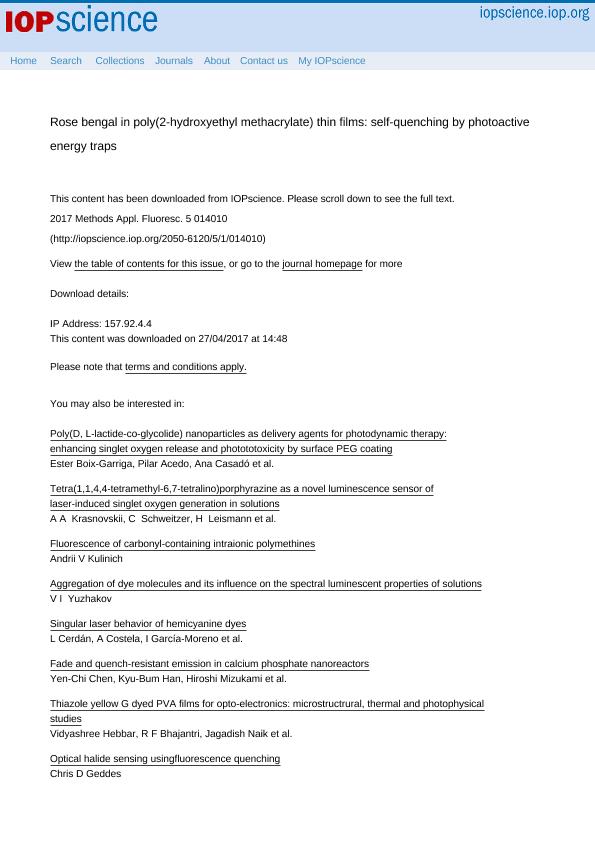Mostrar el registro sencillo del ítem
dc.contributor.author
Ezquerra Riega, Sergio Dario

dc.contributor.author
Rodriguez, Hernan Bernardo

dc.contributor.author
San Roman, Enrique Arnoldo

dc.date.available
2018-11-06T19:52:11Z
dc.date.issued
2017-03
dc.identifier.citation
Ezquerra Riega, Sergio Dario; Rodriguez, Hernan Bernardo; San Roman, Enrique Arnoldo; Rose bengal in poly(2-hydroxyethyl methacrylate) thin films: Selfquenching by photoactive energy traps; IOP Publishing; Methods and Applications in Fluorescence; 5; 1; 3-2017
dc.identifier.issn
2050-6120
dc.identifier.uri
http://hdl.handle.net/11336/63823
dc.description.abstract
The effect of dye concentration on the fluorescence, ΦF, and singlet molecular oxygen, ΦΔ, quantum yields of rose bengal loaded poly(2-hydroxyethyl methacrylate) thin films (∼200 nmthick) was investigated, with the aim of understanding the effect of molecular interactions on the photophysical properties of dyes in crowded constrained environments. Films were characterized by absorption and fluorescence spectroscopy, singlet molecular oxygen (1O2) production was quantified using a chemical monitor, and the triplet decay was determined by laser flash-photolysis. For the monomeric dilute dye, ΦF=0.05±0.01 andΦΔ=0.76±0.14. The effect of humidity and the photostability of the dye were also investigated. Spectral changes in absorption and fluorescence in excess of 0.05Mand concentration self-quenching after 0.01Mare interpreted in the context of a quenching radius model. Calculations of energy migration and trapping rates were performed assuming random distribution of the dye. Best fits of fluorescence quantum yields with concentration are obtained in the whole concentration range with a quenching radius rQ=1.5 nm, in the order of molecular dimensions. Agreement is obtained only if dimeric traps are considered photoactive, with an observed fluorescence quantum yield ratio ΦF, trap/ΦF, monomer≈0.35. Fluorescent traps are capable of yielding triplet states and 1O2. Results show that the excited state generation efficiency, calculated as the product between the absorption factor and the fluorescence quantum yield, is maximized at around 0.15 M, a very high concentration for random dye distributions. Relevant information for the design of photoactive dyed coatings is provided.
dc.format
application/pdf
dc.language.iso
eng
dc.publisher
IOP Publishing

dc.rights
info:eu-repo/semantics/openAccess
dc.rights.uri
https://creativecommons.org/licenses/by-nc-sa/2.5/ar/
dc.subject
Energy Trapping
dc.subject
Fluorescence
dc.subject
Phema
dc.subject
Polymer Films
dc.subject
Rose Bengal
dc.subject
Singlet Molecular Oxygen
dc.subject.classification
Otras Ciencias Químicas

dc.subject.classification
Ciencias Químicas

dc.subject.classification
CIENCIAS NATURALES Y EXACTAS

dc.title
Rose bengal in poly(2-hydroxyethyl methacrylate) thin films: Selfquenching by photoactive energy traps
dc.type
info:eu-repo/semantics/article
dc.type
info:ar-repo/semantics/artículo
dc.type
info:eu-repo/semantics/publishedVersion
dc.date.updated
2018-10-22T22:37:27Z
dc.journal.volume
5
dc.journal.number
1
dc.journal.pais
Reino Unido

dc.description.fil
Fil: Ezquerra Riega, Sergio Dario. Consejo Nacional de Investigaciones Científicas y Técnicas. Oficina de Coordinación Administrativa Ciudad Universitaria. Instituto de Química, Física de los Materiales, Medioambiente y Energía. Universidad de Buenos Aires. Facultad de Ciencias Exactas y Naturales. Instituto de Química, Física de los Materiales, Medioambiente y Energía; Argentina
dc.description.fil
Fil: Rodriguez, Hernan Bernardo. Consejo Nacional de Investigaciones Científicas y Técnicas. Centro Científico Tecnológico Conicet - La Plata. Instituto de Investigaciones Fisicoquímicas Teóricas y Aplicadas. Universidad Nacional de La Plata. Facultad de Ciencias Exactas. Instituto de Investigaciones Fisicoquímicas Teóricas y Aplicadas; Argentina
dc.description.fil
Fil: San Roman, Enrique Arnoldo. Consejo Nacional de Investigaciones Científicas y Técnicas. Oficina de Coordinación Administrativa Ciudad Universitaria. Instituto de Química, Física de los Materiales, Medioambiente y Energía. Universidad de Buenos Aires. Facultad de Ciencias Exactas y Naturales. Instituto de Química, Física de los Materiales, Medioambiente y Energía; Argentina
dc.journal.title
Methods and Applications in Fluorescence
dc.relation.alternativeid
info:eu-repo/semantics/altIdentifier/doi/http://dx.doi.org/10.1088/2050-6120/aa61ae
dc.relation.alternativeid
info:eu-repo/semantics/altIdentifier/url/http://iopscience.iop.org/article/10.1088/2050-6120/aa61ae/meta
Archivos asociados
